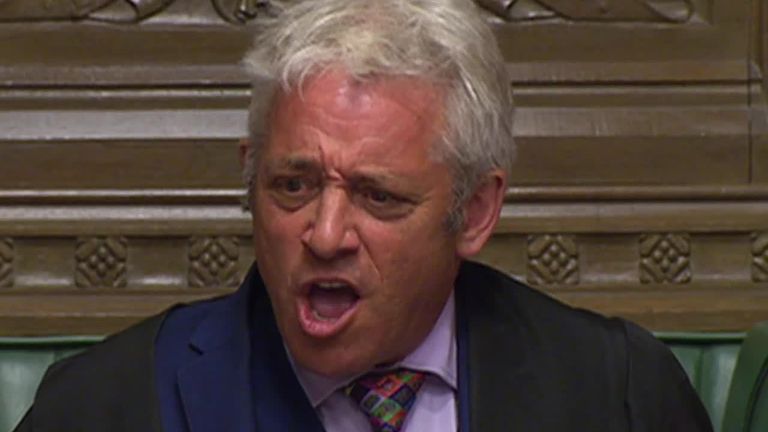Explained: How the next Speaker of the House of Commons is elected
Monday 4 November 2019 12:33, UK
It's the sort of election you don't see very often, but the vote to choose a new House of Commons Speaker is an important and historic one.
It will take place today - parliament's next sitting day after 31 October.
That was the planned date of the UK's departure from the EU before it was delayed again - but also when Speaker John Bercow stood down from the role he has held for more than 10 years.
Here's all you need to know about how the election to pick the person in charge of Commons proceedings is going to work.
Who can put themselves forward?
Quite simply, any MP can stand to be Speaker.
All they need to do is get at least 12 colleagues to support them - but these have to be drawn from three different political parties because the role requires them to be neutral and command cross-party support.
Who are the candidates?
It looks like all of them have already declared - those who have taken part in hustings so far are Sir Lindsay Hoyle, Dame Eleanor Laing, Dame Rosie Winterton, Harriet Harman, Chris Bryant, Sir Edward Leigh, Meg Hillier and Shailesh Vara.
Don't be surprised if you don't know who some of them are - most haven't been on front pages or in frontline politics for a while.
But that's kind of the point - they're usually long-serving MPs who have done their time in the spotlight and have now retired to the backbenches.
Nominations will officially close at 10:30am today and the full official list of candidates published at 11am.
When will the election take place?
Just a few hours later at 2:30pm, the election will take place.
It starts with speeches from each of the candidates, who draw straws in advance to decide what order they go in.
So how do MPs vote?
Every member of the Commons will get a ballot paper with all the candidates' names on it in alphabetical order.
They will then choose their favourite candidate while in the division lobbies - the two corridors MPs usually traipse down to declare if they're voting for or against a motion.
It is a secret ballot, so how each MP votes will not be revealed like in normal Commons votes.
Who wins?
If any candidate gets over 50% they are automatically elected.
If not, that's where it gets a little more complicated.
First, MPs will be asked to vote again - but this time the candidate who receives the fewest votes is removed from the ballot paper, as well as anyone who gets less than 5% in the first round or any candidates who withdraw after the initial ballot.
MPs continue to vote until only one candidate remains or one of them gets over 50%.
The result is then read out in parliament.
What happens then?
An incredibly bizarre spectacle where the winner is dragged - literally - by two supporters from their seat on the green Commons benches and up to the Speaker's chair.
The tradition originates from a time when the Speaker used to report to the monarch on parliamentary proceedings.
If the king or queen didn't like what they heard, they could execute the MP - meaning some were understandably not keen to take on the role of Speaker.
The winning candidate will probably make a short speech, followed by ones of congratulations from the party leaders.
Then they will have to go to the House of Lords for a ceremony - in keeping with parliament's taste for complex, legalistic procedures - known as the "Royal Approbation of the Speaker".
Unsurprisingly it involves a lot of bowing, hat doffing and red robes and should last about ten minutes.
When the Speaker returns to the Commons with all the ceremonial hoops jumped through, they will be given a special robe to wear.
And, after all that, they'll officially be a new Speaker.








